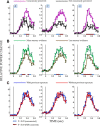Local category-specific gamma band responses in the visual cortex do not reflect conscious perception
- PMID: 23100413
- PMCID: PMC6704831
- DOI: 10.1523/JNEUROSCI.2051-12.2012
Local category-specific gamma band responses in the visual cortex do not reflect conscious perception
Abstract
Which neural processes underlie our conscious experience? One theoretical view argues that the neural correlates of consciousness (NCC) reside in local activity in sensory cortices. Accordingly, local category-specific gamma band responses in visual cortex correlate with conscious perception. However, as most studies manipulated conscious perception by altering the amount of sensory evidence, it is possible that they reflect prerequisites or consequences of consciousness rather than the actual NCC. Here we directly address this issue by developing a new experimental paradigm in which conscious perception is modulated either by sensory evidence or by previous exposure of the images while recording intracranial EEG from the higher-order visual cortex of human epilepsy patients. A clear prediction is that neural processes directly reflecting conscious perception should be present regardless of how it comes about. In contrast, we observed that although subjective reports were modulated both by sensory evidence and by previous exposure, gamma band responses solely reflected sensory evidence. This result contradicts the proposal that local gamma band responses in the higher-order visual cortex reflect conscious perception.
Figures



References
-
- Aru J, Bachmann T, Singer W, Melloni L. Distilling the neural correlates of consciousness. Neurosci Biobehav Rev. 2012;36:737–746. - PubMed
-
- de Graaf TA, Hsieh PJ, Sack AT. The ‘correlates’ in neural correlates of consciousness. Neurosci Biobehav Rev. 2012;36:191–197. - PubMed
-
- Dehaene S, Changeux JP. Experimental and theoretical approaches to conscious processing. Neuron. 2011;70:200–227. - PubMed
Publication types
MeSH terms
LinkOut - more resources
Full Text Sources
